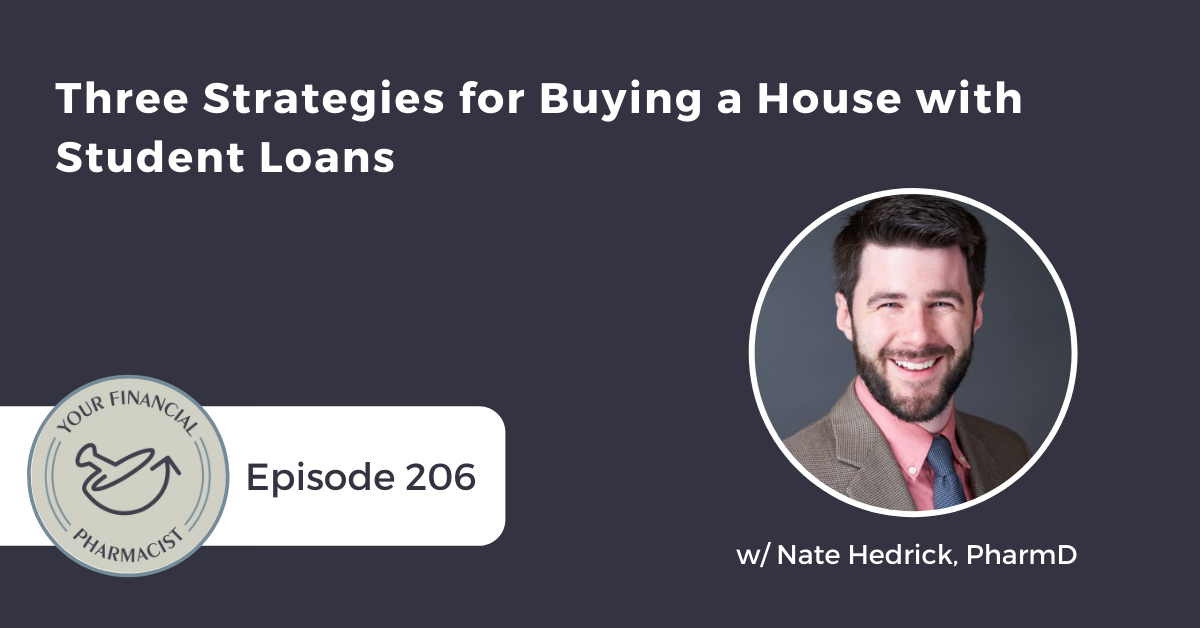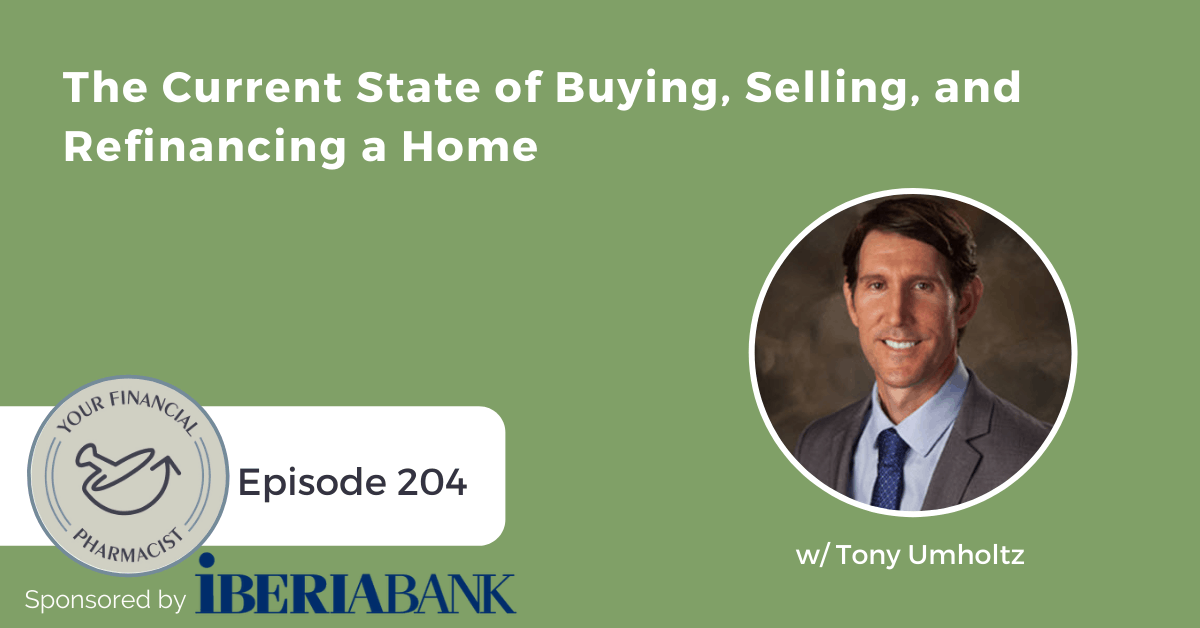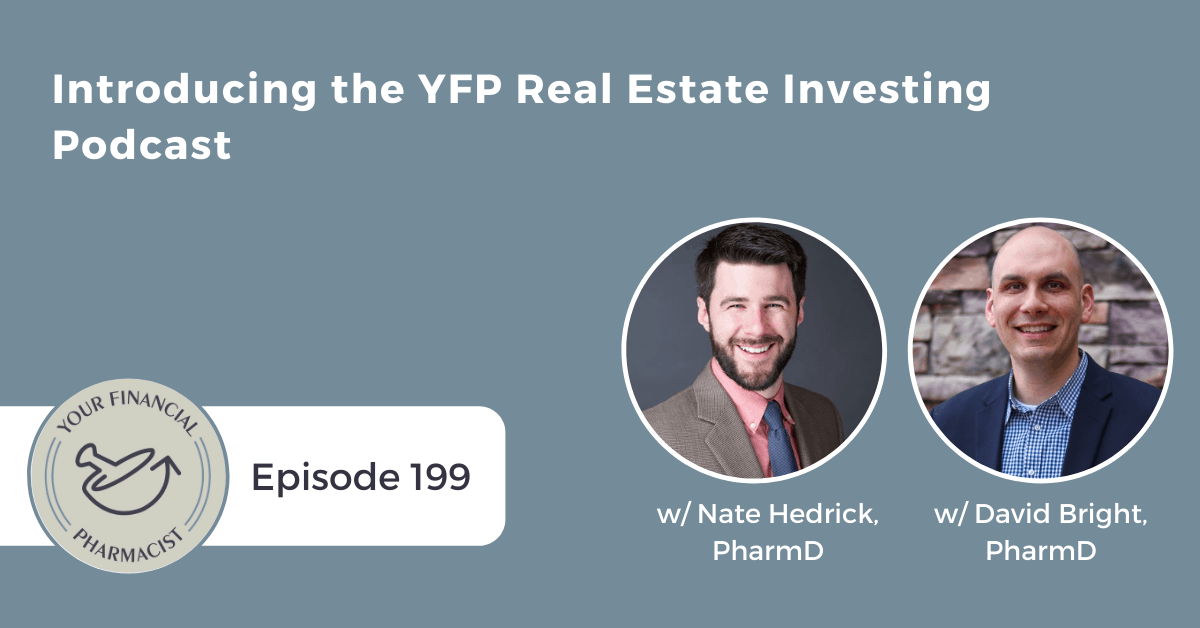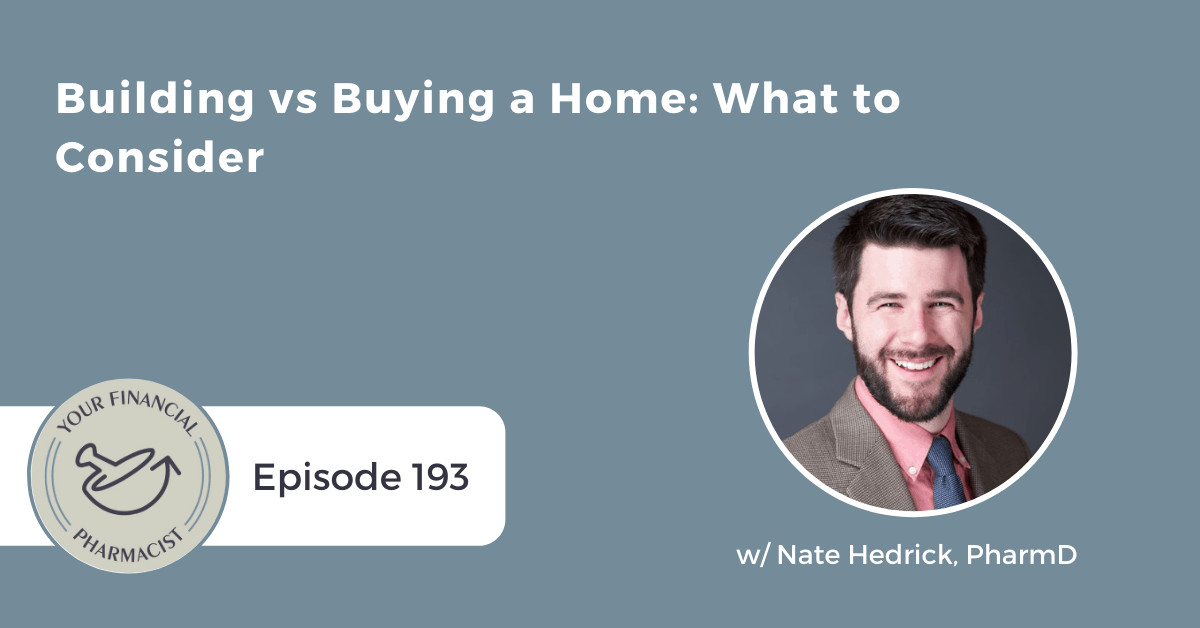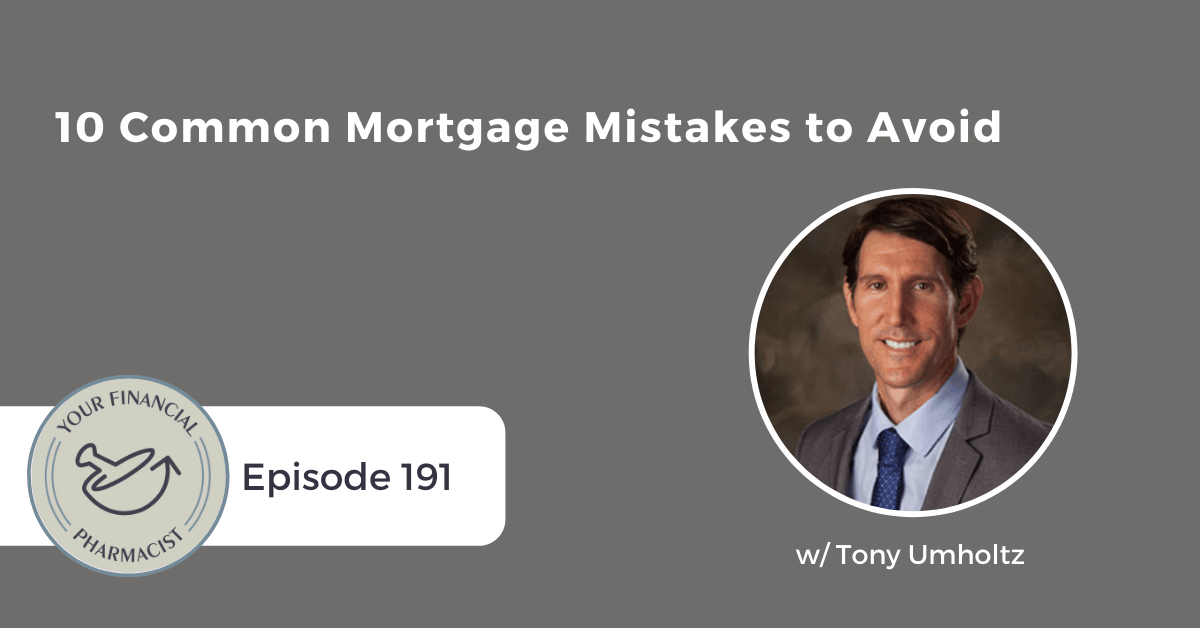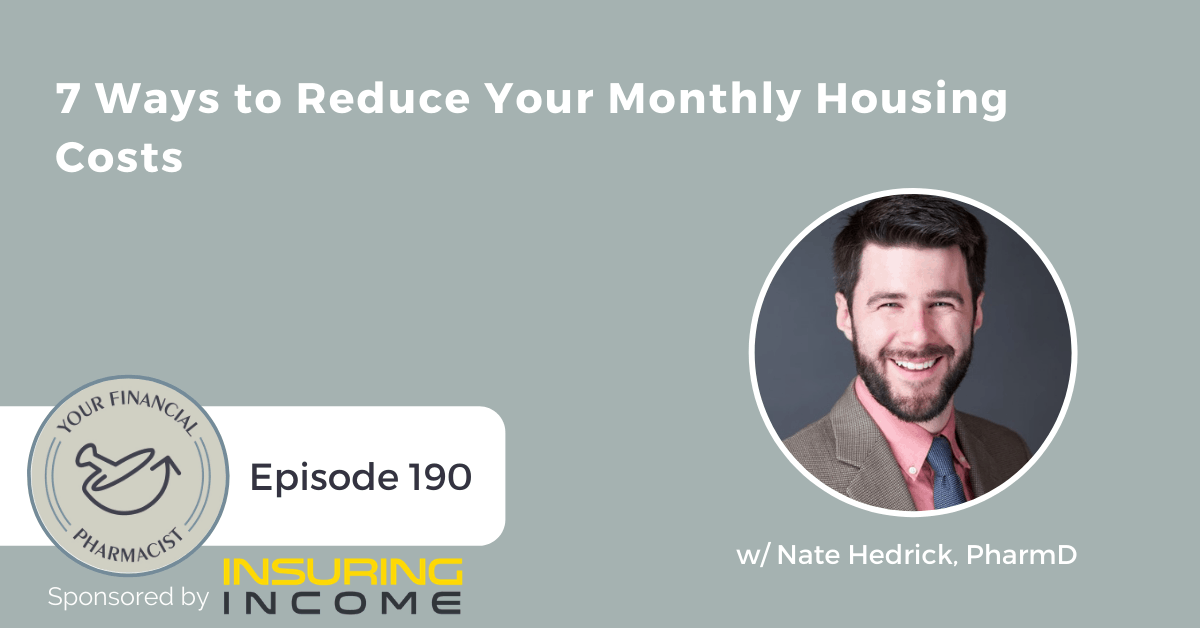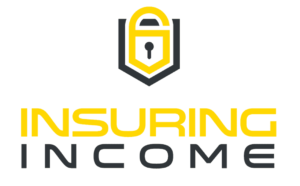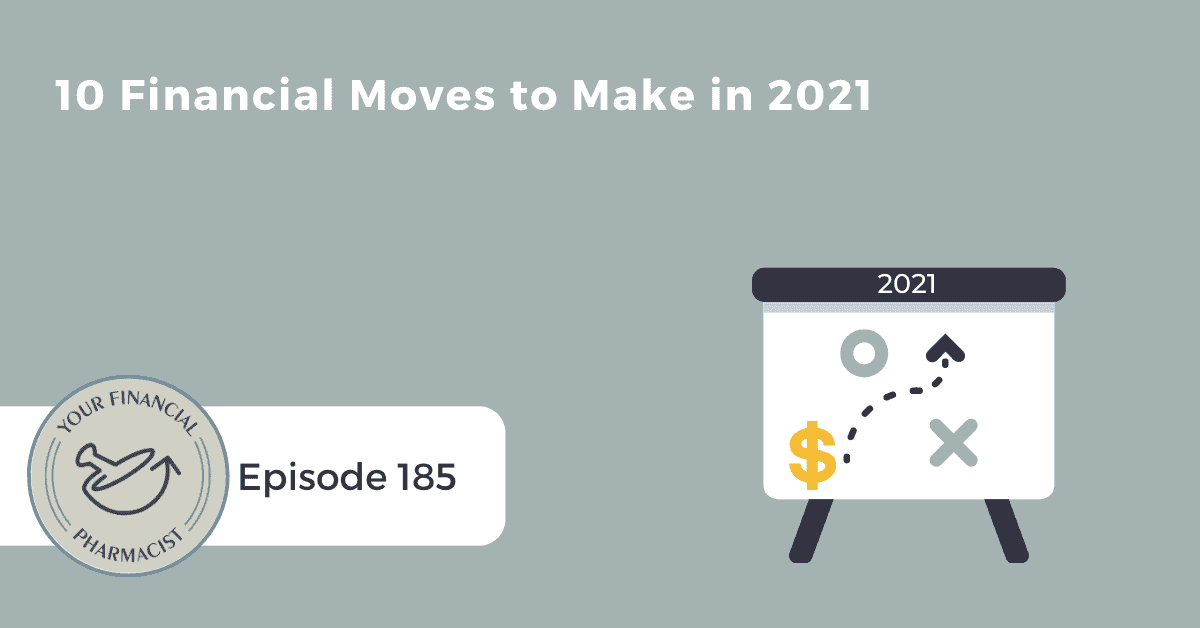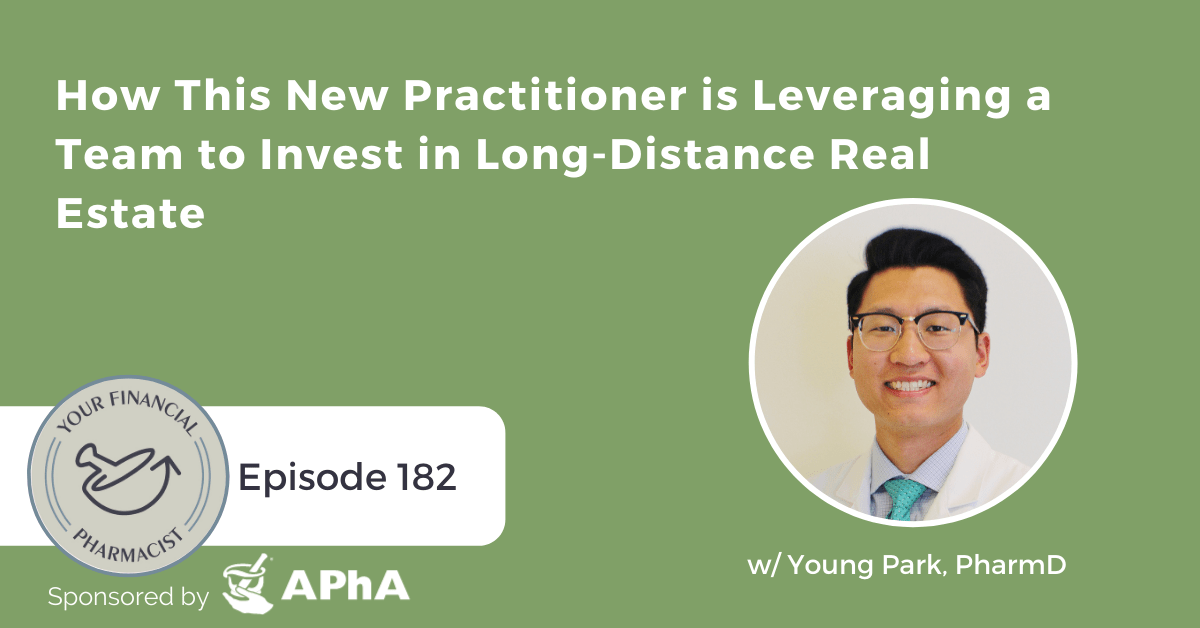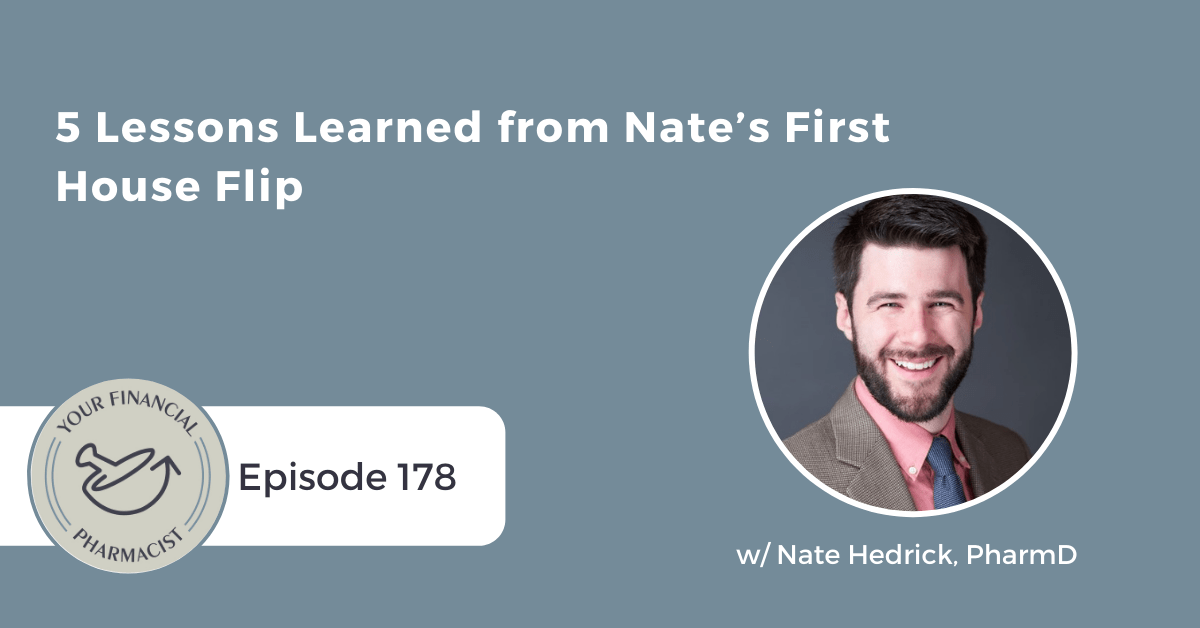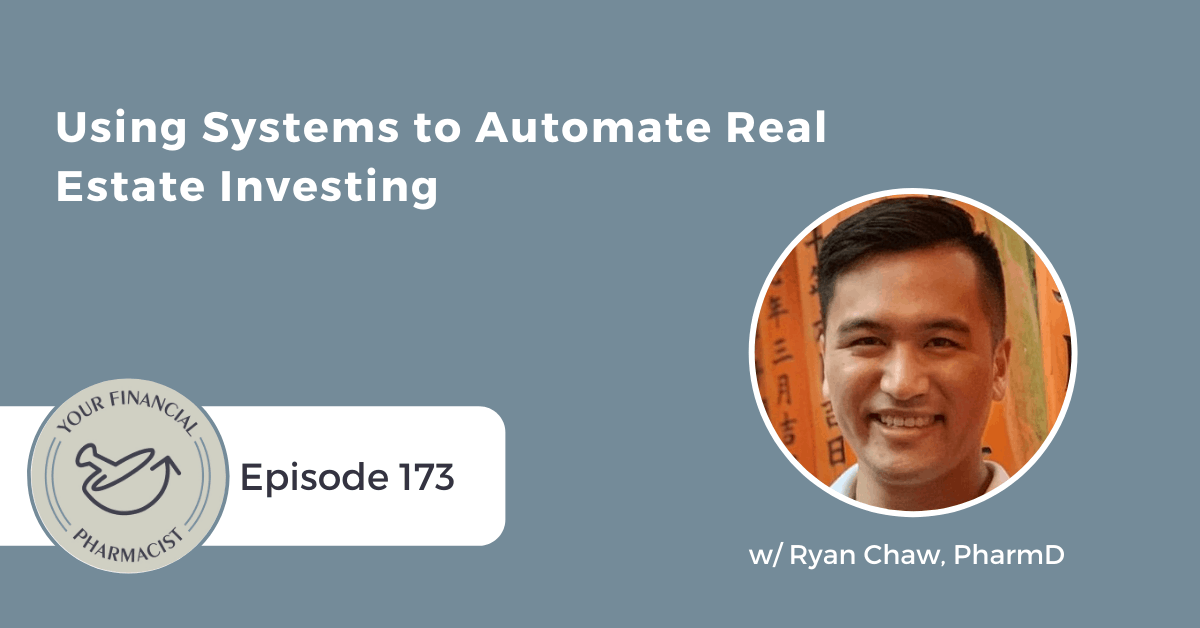Three Strategies for Buying a House with Student Loans
Nate Hedrick discusses strategies for buying a home with student loans. He talks about the decision to rent vs. buy, how to determine when you’re ready to buy, and three strategies to consider when deciding to buy a home with student loans.
About Today’s Guest
Nate Hedrick is a full-time pharmacist by day, husband and father by evening and weekend, and real estate agent, investor, and blogger by late night and early morning. He has a passion for staying uncomfortable and is always on the lookout for a new challenge or a project. He found real estate investing in 2016 after his $300,000+ student loan debt led him to read Rich Dad Poor Dad. This book opened his mind to the possibilities of financial freedom and he has been obsessed ever since. After earning his real estate license in 2017, Nate founded Real Estate RPH as a source for real estate education designed with pharmacists in mind. Since then, he has helped dozens of pharmacists around the country realize their dream of owning a home or starting their investing journey. Nate resides in Cleveland, Ohio with his wife, Kristen, his two daughters Molly and Lucy, and his rescue dog Lexi.
Summary
Nate Hedrick returns to the show to discuss knowing when you are ready to buy a home, questions to ask yourself to gauge your readiness, and three strategies for buying when you have student loans.
The first strategy for buying a home when you have student loans is to buy a home as soon as possible. The advantages of this strategy include immediate emotional satisfaction, being your landlord, building equity in your home, and tax advantages for homeownership realized. The disadvantages include high upfront costs, increased likelihood of paying PMI, the effect the purchase may have on your budget, and the decrease in flexibility to move at will.
The second strategy is to pay off your student loans first, then buy a home. The advantages to this strategy are emotional relief from debts being gone, increased flexibility in the budget, and potentially increased emergency funds should problems arise. Disadvantages to this strategy include a period of renting and not building equity, potential loss of market appreciation, potentially missing out on historically low-interest rates, and delayed access to tax benefits.
The third strategy is more of a hybrid model. In this strategy, the homebuyer pays down the student loans and then buys a home. With this third strategy, there may be a feeling of relief and confidence, less overall debt, and a lower risk of defaulting on payments. Disadvantages are the same as the second strategy, though generally for a shorter time.
Mentioned on the Show
- YFP Planning: Financial Planning for Pharmacists
- Register for the Free Webinar: Investing Beyond the 401(k)/403(b)
- Baker’s Dirty Dozen: Principles for Financial Independence by Joe Baker, MBA with Lindsey Jordan Baker
- The Pharmacist’s Guide to Conquering Student Loans by Tim Church, PharmD
- YFP Real Estate Investing Podcast
- Real Estate RPh
- Dave Ramsey
- YFP 018: Maximizing the Benefits of Public Service Loan Forgiveness (PSLF)
- YFP 062: The ‘Other’ Forgiveness
- YFP 078: Is Pursuing the Public Service Loan Forgiveness Program a Waste?
- YFP 114: Presidential Candidates’ Plans for Student Loan Forgiveness
- YFP 176: How Stephanie Got $72,000 Forgiven Through TEPSLF
- YFP 040: 10 Things Every Pharmacist Should Know About Home Buying (Part 1)
- YFP 041: 10 Things Every Pharmacist Should Know About Home Buying (Part 2)
- YFP 064: 6 Steps to Home Buying (Part 1)
- YFP 065: 6 Steps to Home Buying (Part 2)
- YFP 190: 7 Ways to Reduce Your Monthly Housing Costs
- YFP 149: Crushing 400k of Debt in 5 Years
- Three Strategies for Buying a House with Student Loans
- YFP Real Estate Concierge Service
- Book a Free Call with the YFP Real Estate Concierge
Episode Transcript
Tim Ulbrich: Nate, welcome back to the show.
Nate Hedrick: Hey, Tim, great to be here.
Tim Ulbrich: It’s been so fun to hear you and David on the Real Estate Investing podcast as hosts. I shared with you before we hit record, I’ve enjoyed being a fan of the show, love hearing other pharmacists’ stories about their real estate investing journey. So kudos to you and David on the work that you’ve been doing. That’s not what we’re going to talk about here today, though. I want to bring you on as a guest in your role as The Real Estate RPh, someone who has expertise on the home buying side, also being a real estate agent, so we can dig into the topic that I think is front-of-mind for so many pharmacists out there, especially in this real estate market, and that is buying a home while still dealing with student loan debt. So Nate, before we jump in, I think folks if they’ve listened to any of the news lately, they know the chaos that is the real estate market right now. But just give us a quick pulse from what you’re seeing in your market in Cleveland and obviously as an agent in helping other pharmacists.
Nate Hedrick: Yeah, absolutely. And thanks, it’s been really fun getting started with the podcast. And David and I are having a blast meeting all these great pharmacists doing real estate investing. And it’s been a really fun time. So but yeah, the market right now is obviously a big seller’s market. There is very low inventory. The interest rates are low, so it’s driving up people that want to buy because money is cheap. And so we’re seeing a lot of bidding wars. Houses come on the market and there’s 10 or 11 offers by Saturday afternoon and people are looking for highest and best by Sunday evening. And so it’s just — it’s a bit crazy. It’s nice for a market with my sellers. I had a listing that was on the market I think — I don’t know — two or three days that we got a full-price ask. So it’s really nice to have listings, but my buyers, it’s a lot of work. We’re doing a lot of offers that include escalation clauses, which bump up the price, and appraisal gap coverage and all kinds of crazy stuff.
Tim Ulbrich: I was thinking about you last week, you know, for agents that are obviously working with the buying and the selling side, like what a difference of just — I mean, effort of course and work but also I mean, you know, on one end you might be working with somebody who’s putting in one offer that is one of 10, 15, 20 offers. On the other end, it’s like, keep them coming. Keep the offers coming and we’re going to react to the best one.
Nate Hedrick: Yeah, I had a physician client, two young physicians, new residency here in Cleveland, they’re moving from D.C. back to Cleveland. And I think we ended up looking at — it had to be 60 houses. It was the most I’ve ever seen with one client. And there’s other real estate agents that are listening that are probably like, that’s not a lot. But for me, that was a ton, a ton of houses. We did one offer every week and one offer every weekend, so two a week at least. It took us 10 or 11 houses, or 10 or 11 offers to get something accepted for them. But they’ve got a great house. It just took a ton, a ton of effort to get them there.
Tim Ulbrich: Yeah. Persistence for sure. So let’s talk about home buying and student loans. You know, our audience knows well that pharmacists today are facing big mountains of student loan, $175,000 is the median indebtedness for a pharmacy graduate in 2020. Hopefully we’ll be getting the 2021 data here soon. But I think we know where that number is going to be going. And we often hear from folks in the YFP community as well as prospective financial planning clients of ours at Your Financial Pharmacist Planning that pharmacists are often trying to juggle several competing financial priorities, which really of course depends on the person, right? It could be buying a home, paying down debt, investing, saving for retirement, the list goes on and on. And what we often do when it comes to comprehensive financial planning is we’re working with clients to help them determine their financial and their life goals and to ultimately develop and establish a plan to help those individuals reach those goals. So when we talk here about student loan debt, obviously one big goal that we hear from many folks in the community, a big barrier is I want to get a home, but I’ve got all this student loan debt. And when is the right time? And so I think there’s this question of, is there a best time? You know, what are the different options that are out there? So Nate, high level, what do you think of as kind of the buckets or strategies that folks may be thinking about when it comes to buying a home while also focusing on student loan repayment?
Nate Hedrick: Yeah, and I think this is, you know, regardless of the market, there are three main options for what this looks like. And you do this in a buyer’s market or a seller’s market. But you know, Option 1 is kind of the “I want everything now,” right? Buy a home ASAP. Go ahead and just do it. Option 2 would then be the opposite of that where you’re paying down all your debt first and then you buy a house, and that’s like the very Dave Ramsey approach. And then there’s Option 3, which we’ll talk a lot about I think as we go through this. But that’s kind of what I call the hybrid approach, where you’re looking at getting rid of the bad debt first and then going ahead and purchase that home, even though you’ve got some of those student loans in place. And we’ll talk through those details.
Tim Ulbrich: So we’ll dig into each of those strategies. First things first, you have to decide if it’s renting, is it buying, what’s the best move for you going forward? And really, if you do choose to buy a home, knowing whether or not you’re ready and being prepared to do so. So Nate, just some initial thoughts on how can someone determine if they are ready to buy a home.
Nate Hedrick: Yeah, absolutely. I think there are a lot of things you can do in advance to make sure that you are prepared for that process and some questions you can kind of evaluate to determine is it right for me to rent? Is it a good time for me to jump in and start buying? And again, how do my other finances fit in with that? So you know, for example, are your student loans at a point where they are causing you significant stress? That’s just one easy-to-answer question, right? Are these driving me crazy? Are they the thing that I can’t stop thinking about? Or is it that I need to go buy a house first? And if your answer to that question becomes, absolutely, I’ve got to get rid of these student loans, it’s the thing that’s killing me, maybe you need to wait on that house purchase. And so questions like that can help you start to figure out where are your priorities, and then you can start looking at the actual financial pieces. You know, for example, do I have an emergency fund? Am I contributing to my retirement fund on a regular basis? Right? I would typically advise somebody to have those things in place first before going out and purchasing a home. You know, there are advantages to buying that house but not in replacing your emergency fund or taking away from your retirement just so you can go do it. So those early financial questions I think are a really good place to start so that you know your priorities before deciding what strategy is right for you.
Tim Ulbrich: Yeah, Nate, what I like about those questions, one thing I talk often about on the show — our audience has heard me on repeat say this — is really trying to avoid making any financial decision in a silo. Right? Taking a step back and saying, what else is going on with the financial plan? And I think in this scenario, right, we’re talking about home buying, we’re in the spring of 2021, the market is en fuego, like you’re talking to peers and friends and colleagues and others that are buying homes, it’s all over the news, interest rates are low, like that puts the pressure — perhaps — on like OK, got to buy, got to buy, got to buy, especially if folks are having that as an interest. And these questions, you know, are my student loans and other debt causing significant stress? What about my emergency fund? Where am I at with my retirement funds? Where are the contributions? How might this position to buy v. continue to rent ultimately direct that? So really taking that step back and asking those questions and also being fair that rent prices right now are also en fuego. So like this may not be necessarily just a home prices are escalating, therefore it’s best to stay put. But I think asking these questions to really try to evaluate it, you know, as objectively as you can with the rest of your financial plan in consideration. So let’s dig into those three strategies that you mentioned, Nate. And we’re talking here again about paying off student loans while also looking at purchasing a home. You mentioned No. 1 is “I want it now,” right? So ultimately, you know, getting the home as soon as possible and really focusing on that. The second approach you mentioned is really more of that Dave Ramsey type of approach of OK, let’s pay down all of the debt and then we’ll even think about a home after that. And then the third you mentioned is more of a hybrid approach. So let’s start with No. 1, the “I want it now,” buy a home as soon as possible. So who is this strategy for? Talk to us more about some considerations around this strategy.
Nate Hedrick: Yeah. And so full disclosure, this was me about seven years ago, right? We had come out of pharmacy school and residency and decided we wanted a house. We wanted space to call our own, we wanted space for our dog, we wanted — like, you name it, there were 10 reasons why emotionally we were ready to have a house. And so for us, it became alright, that’s going to be the driving decision, we’ll figure out the costs later. I don’t care, we’re going to buy a house. And so this strategy is really for those people that say, “Look, I am ready to jump in. I am comfortable with where my student loans are at, or comfortable enough that I can take this financial responsibility, and it’s time for us to dive in and take a look at purchasing that actual house.”
Tim Ulbrich: Yeah, the other group I think about here too, Nate, you know, without getting into the weeds of student loans, would be for those that are pursuing a forgiveness option, right? So whether it’s PSLF, Public Service Loan Forgiveness, non-Public Service Loan Forgiveness — if you’re hearing those terms for the first time or want any more information, check out any previous YFP episode. I think we’ve talked about them. But you know, when I think about the strategy around forgiveness, now, granted if that is the right move, which is a further conversation back to my point about not looking at things in a silo — if Public Service Loan Forgiveness of non-Public Service Loan Forgiveness is the path forward, typically the strategy is then, OK, what can we do to minimize payment, maximize forgiveness. Well in that case, there might be additional cash flow, right, that’s there on a month-by-month basis that may not be the case if somebody’s let’s say in an aggressive repayment, either in the federal program or in the refinance. So great example where student loan strategy can really intersect here with the home buying discussion and decision as well. So advantages and risks. So as we talk about this strategy, Nate, buy a home as soon as possible, “I want it now,” what are some advantages? What are some potential disadvantages or risks?
Nate Hedrick: Yeah. I think most of the advantages here are emotional, right? I think they’re kind of obvious from that standpoint. You get the house, you get to become a landlord right away. But there are a couple of financial advantages as well. One is that you build that equity and that credit right away. I mean, if you had been in my shoes seven years ago and now where the housing market is today, right, our house has gone up tremendously in value just sitting here and enjoying it. So there is some advantage to that. You’ve got tax advantages as well. You know, you get to pay down or at least deduct in some capacity your mortgage interest and some of your property taxes in some cases. So there are definite financial advantages, but I think in this strategy, most of the advantage side is leaning toward the emotional aspects. And then on the risks or the disadvantages I guess, you know, obviously there’s less flexibility built in. You know, renting is great because you have that flexibility if your job changes or if you want to go to a different location. There’s higher upfront costs from doing it this way. Obviously you’ve got a lot more debt load, a lot more debt-to-income ratio is being increased by doing this. So you know, from a financial aspect, it’s a bit more tricky for sure.
Tim Ulbrich: Yeah, and I think I’ve talked about this on the show before when we had a discussion on renting versus buying — we’ll link to that previous episode in the show notes — but you know, don’t forget about all the other costs. Right? We’ve talked about this on other episodes before, all of the other costs that come along with the home purchase, not necessarily just doing a rent payment comparison against what would it be with mortgage .Obviously you’ve got taxes, you’ve got insurance, you’ve got things that you need to furnish the home, take care of the house, etc., other costs that can be a significant factor. So strategy No. 2, get rid of all of the debt, then buy a home. Now I know folks are going to hear this, Nate, because I was in bucket No. 1, right, so I’m with you there. You know, folks that are looking at $175,000-250,000 of debt, like seriously? Like wait until I have all of that paid off? I mean, you know, some may — as we’ve had featured on the show before — some might be able to knock that out in 2, 3, 4 years very aggressively. But many folks are looking at 10, 15, 20-year repayment. So where does this strategy fall? What might this be an opportunity for some folks to consider when we talk about getting rid of all of your loans and then buying a home?
Nate Hedrick: Yeah. I definitely think this plays into someone who might have a smaller debt load than the average pharmacist. And by smaller, you could still be talking about $60,000, $70,000, $80,000 but something that you can tackle in 1 or 2 years if you really were aggressive with it. I think you’re right, the typical pharmacist or even the typical pharmacist couple in some cases where you’re coming out with $300,000 together in debt, like it’s just — it may not be possible to choose this strategy and still make financial sense. But there are plenty that do it. I mean, take a look at Tim Church’s story, right? He went out and him and his wife really focused every dollar on getting rid of that debt first and again, because it was a major pain point for them. They said, “I hate this debt. And the idea of taking on more makes me sick to my stomach. I can’t do it.” So if you’re one of those people, this might be the right call for you.
Tim Ulbrich: Yeah, and I think that’s a good reminder, you know, Nate, of like really being true to how you emotionally feel. Here, we’re talking about how you emotionally feel about debt but also it will be about how you emotionally feel about other parts of the financial plan and not necessarily just what someone else is doing or what else you have read but really being true to how do you feel about that. And then this case, an obvious advantage would be if you just hate the idea of that student loan debt and you can really aggressively pay that off, then obviously the advantage being you’re going to have a lot of relief from having no other debt and be able to move into that home in a very confident financial position. So that of course is one advantage. What are some other advantages that you think about with this strategy as well as some disadvantages or risks?
Nate Hedrick: Yeah. From the advantage side, I definitely think that you have more flexibility once you get there. Right? All of the advantages are kind of once you get there. But you have that more flexibility in your budget when you’re ready to buy a home, you’ve got greater cushion, you can make bigger mortgage payments, especially if something unexpected comes up. So I know a couple of physician and pharmacist friends who are looking at methods like this where they want to get rid of their debt first so that one of them can cut back on their hours and they can still afford that home that they want to purchase. So there are definitely — it provides more flexibility, but again, a lot of those advantages don’t kick in until you paid off that debt. So you’re kind of sitting on the disadvantages until that point. And so again, obviously the risks there are it could take you several years to get there and you’re not building any equity in that time. And so you could miss out on significant market appreciation. You also could miss out on locking in these great interest rates that we’re having right now. I mean, we are talking about truly, truly historic lows. They’ve come up a little bit in the last couple of months as buying interest has increased, but I mean, truthfully, you cannot get interest rates much lower than they are right now. And so you might miss out on that if it takes you 2 or 3 more years to get access. And then of course, you know, there are very few advantages for income earners like ourselves in terms of tax implications. But getting a mortgage is one, and so you miss out on that small advantage as well.
Tim Ulbrich: I think interest rates is an interesting conversation, especially for those that are new graduates that are looking for a home or recent graduates. You know, Nate, it feels like — you know I graduated 2008, you were a few years after that — like we’ve been in a historically low interest rate period. Right? So I don’t feel like I have an appreciation — like when we say historically low rates, it’s like, yeah, they are relative to where they’ve been, but they were still really good just a couple years ago. And before that, we were talking about historically low rates that were there as well.
Nate Hedrick: Right.
Tim Ulbrich: So we don’t have the perspective. Like go talk to my parents or talk to my grandparents, and you hear stories of double-digit interest rates and other things. So definitely an important consideration, but I think it has become somewhat of a norm that we’ve been used to here more recently. But who knows where that will go here in the next year or so?
Nate Hedrick: Definitely.
Tim Ulbrich: Third strategy you mentioned, Nate, is a little bit more of a hybrid approach. So what do you exactly mean by that?
Nate Hedrick: Yeah, and so this is one that I really advocate for, which is really getting your financial house in some sort of order and then going off and purchasing that home. So it’s not paying down everything, but it’s also not just jumping in head first. What this looks like is getting those student loans either refinanced or into a student loan forgiveness program or under some sort of control, getting rid of the other bad debt that you might have, credit card debt, for example, getting rid of that stuff first, the things that are really going to outpace any of the advantages you get with purchasing a home. And once you’ve got that in line, you’ve saved up a sizable down payment so that you’re avoiding things like PMI or any sort of getting rid of your emergency fund, then you go forward and purchase that home. So it’s really about maximizing the benefits, minimizing the risks and trying to balance that out.
Tim Ulbrich: Yeah, this really intrigues me, Nate, and I wish I would have had you in my ear back in 2009 because I think what resonates with me with this strategy is, you know, I went into the buy a home ASAP. And I think with just a little bit more time, if I would have been able to really better understand like what are all of my student loan repayment options and what is the best fit for Jess and I in this repayment journey — and when I think about this, I think about locking in your strategy. Right? So it doesn’t mean — here, as you’ve articulated, it doesn’t mean you’re debt-free before you’re purchasing a home. That was No. 2. But we’ve got a game plan, and we know exactly what that game plan is, we’ve considered other parts of the financial plan. So whether that’s refinancing, whether that’s loan forgiveness, whether that’s some other plan, we know what that’s going to look like month-to-month, we know what the total amount is going to be paid or total amount that also may be forgiven in a forgiveness plan. And so now, we can put in that one puzzle piece of the plan of the student loans so we can then start to move these other puzzle pieces like the home in around it. Right? But we’re not moving into the home purchase decision still wondering like, what is the student loan plan? You know? What might this look like? We talk often on this topic, webinars and speaking events and other things, and I often will show a slide and a chart that shows for a pharmacist coming out with $150,000 or $200,000 of debt, if they choose Option A, B, C, D, or E when it comes to student loan repayment, whether that’s forgiveness or non-forgiveness, federal or private, there’s a difference, big difference that can happen on a monthly payment basis as well as what’s paid out over the life of the loan. So if that’s a question mark, you know, and you haven’t evaluated those options, I think it’s really difficult to know where does that home piece fit in around that, if the payment is going to look like on a month-to-month basis is still unknown. So talk to us then, Nate, about the advantages and disadvantages of this strategy when it comes to this hybrid approach of paying down the student loans and having a strategy while also moving forward with home buying.
Nate Hedrick: Yeah, I think this really tries to play into the advantage — it really ups the advantages where it can and then it kind of disengages those risks wherever it’s possible. So for example, you’ve got that feeling of relief because you’re going to have the student loans under some sort of control, right? They’re not going to be gone.
Tim Ulbrich: Yeah.
Nate Hedrick: But maybe you’ve refinanced them down to 3% now and now you know, OK, this is basically like inflation money. I have my payment, I’ve got that figured out every month, and I can stack things on top of that. It also helps because hopefully you’re going to be taking on less overall debt, especially if you’re taking the time to build up that down payment, that emergency fund, you know, and maybe you’re paying off things like — or you’re getting enough down payment that you’re going to avoid PMI or using a pharmacist home loan product to avoid PMI. All of those things are going to help you in taking on less overall bad debt. So those big advantages, and then again, kind of the ultimate is that if something does happen, right, if you lose a job, if you miss out on work for a period of time, or someone needs to cut back on hours, you have a lower risk of defaulting on those payments because you’ve set yourself up for success from the beginning. It’s not perfect, you’ve not paid down all that debt going into it. But you’re getting that home a little bit sooner, and you’ve got this cushion built in that may help you out. The disadvantages is obviously this still could take time, right? You could still take 2 years to approach this hybrid model where it makes sense. I like to think that you can pull this off in probably a year, a year and a half, because really, truly getting that down payment saved up in that time should be doable, especially using like a pharmacist home loan product. But you are waiting. It’s not getting the house tomorrow. It’s giving it a little bit of time still.
Tim Ulbrich: Great stuff. And for those that heard the three strategies and the discussion we’ve had here today and want a refresher without going back and hitting replay on this episode, Nate has put this into a blog post, “Three Strategies for Buying a House with Student Loans.” That’s available at YourFinancialPharmacist.com, on the YFP blog, and we’ll link to that in the show notes. Nate, I want to spend a few minutes and talk about the Real Estate RPh concierge service that we offer to the YFP community because I think that many folks that are listening to this are probably somewhere in the stages of home buying, whether that’s a hey, I’m out there looking right now, or I’m going to get started. Maybe it’s three months out, six months out, whatever be the case. But we know how important it is to have an agent that understands your situation and really ultimately has your best interests in mind. And we’ve got the advantage of having you, Nate, as someone who both understands the pharmacist, is a real estate agent, has gone through this process of student loan repayment and making a decision to buy a home, and I think that perspective can be incredibly valuable to other pharmacists that are in the home buying decision-making process. So Nate, tell us about exactly what is the real estate concierge service and what folks can expect as they go throughout that.
Nate Hedrick: Yeah, so this goes back to when I bought my first house. And it came time to get myself an agent, right, I knew I was a buyer, I knew that getting an agent was basically free. But that’s about all I knew, right? I knew that I needed to go find one. And so I started asking my friends. And someone said, “Oh yeah, here, use this person.” And they were fine. They did their job OK. But as I learned more about real estate, becoming an agent, working with clients, I realized there was a lot of things that they could have done differently and that I wish I would have known as a buyer from the beginning. And so I said, “We can improve that for other people. Let’s go out and do that.” And so what I do is I actually connect with potential buyers, with pharmacists like yourselves or with anybody that’s looking to purchase a home anywhere in the country. We do a 30-minute planning call. It usually doesn’t take that long, but I at least set aside that 30 minutes to answer questions, go through the home buying process with you so that you can fully understand it, ask any questions that you have about it, and then once we have that conversation, I go out and I find you a great real estate agent. And sometimes it’s somebody we’ve already worked with, we’ve helped over 30 pharmacists close on houses at this point, which is pretty fun. And — so it might be somebody we’ve already worked with in the past, or it might be somebody that we simply know from interviewing them. And so I’ll go out and I’ll interview agents, try to match up someone who I think is going to be a really good fit for you. And then we get you connected, and you get off to the races with this great, personally-vetted agent. The other cool thing is that I don’t leave once that connection takes place. I get to be still a part of your team. And so if you need a second opinion, if you just want to bounce ideas off of me, somebody that isn’t your agent but is an agent, you can come right back to me, sign up for another call, send me some emails. You know, it just gives you that person in your back pocket that knows and understands this process to really help you out. And so it’s been a great tool for our pharmacists to tap into and our community to tap into. We’ve had a lot of success over the last year or so.
Tim Ulbrich: Yeah, that’s great, Nate. And for our community, this really initiated I think in part because of really the value that I see Nate brings to the community, his expertise in this area. We’ve known each I think for the better part of a decade now.
Nate Hedrick: Yep.
Tim Ulbrich: I realized that this topic of home buying is something that close behind student loans and some others is really top-of-mind for our community and going through this process firsthand a couple times, know how important it is to have a good agent that is in your corner. So —
Nate Hedrick: Especially in this market.
Tim Ulbrich: Yes. Big yes.
Nate Hedrick: I mean, having somebody that’s going to be able to fight for you and understand what kind of things are going to get the deals done — if you’re a buyer, I mean, that is so, so essential right now. I’ve seen tons of people that just get frustrated because the agent they’re working with isn’t helping them along or not explaining it to them well enough, and then they just say, “You know what, forget it. I’m just going to rent for another year. I’ll figure it out later.” But a lot of the agents that we work with, like they understand this market, they work in it every single day. And they’re able to navigate it for you and help you actually achieve that home buying process.
Tim Ulbrich: Yeah, and full disclosure, as Nate mentioned, the service is completely free to use for the buyer. If you work with an agent within the network that is referred and end up closing on a property, then that agent pays a small commission back to Nate. So that’s full transparency of how the process works. Obviously having Nate in your corner can be a valuable resource. We know that home buying, it’s an exciting experience, it can also be overwhelming at times. You’ve got finding an agent, financing, searching for the place, this market, as you mentioned, Nate, so that’s really the value I think that can be brought through the concierge service and working with Nate. So for those that are interested, YourFinancialPharmacist.com, top of the page, you’ll see Buy or Refi a Home. Then you can click on Find an Agent. That’ll get you connected to getting some time on Nate’s calendar. And we’ll also link to that directly in the show notes. Nate, as always, appreciate you taking the time, appreciate your expertise, and looking forward to having you back on the show in the future.
Nate Hedrick: Yeah, thanks for having me. And we’ll talk again soon I’m sure.
Current Student Loan Refinance Offers
[wptb id="15454" not found ]Recent Posts
[pt_view id=”f651872qnv”]

